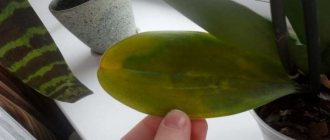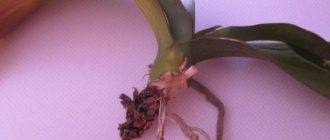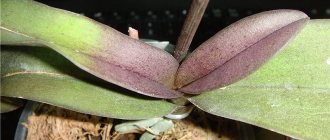When a store sells indoor orchids at a price 2-3 times lower than usual or friends offer to pick up a drying plant for free, it’s hard to resist. Even if the orchid’s leaves turn yellow and begin to dry, and the roots turn brown, such a plant can be saved. You just need to transplant it correctly. Indoor orchids are rather capricious plants. This is due to the fact that their homeland is a tropical jungle. It is quite difficult to maintain a regime suitable for a flower in indoor conditions.
Improper care can lead to the fact that within a few weeks you will have to think about how to revive the orchid from the consequences. Very often, orchids begin to have difficulties with roots. Don't be discouraged. A withered plant, even with rotten roots, can be revived. In order to understand how to resurrect a dying plant, you need to understand the factors of the problems. Often, improper care is to blame for the roots rotting. Orchid loves diffused light. Very often, difficulties with the root system of orchids begin in the autumn-winter period. Therefore, from September to March you need to take extremely close care of the plants. In the warm season, actively growing, flowering orchids feel comfortable in natural conditions, easily tolerating the lack of lighting, heating and additional air humidification. What is the reason that orchids die at home, and how to save a beautiful flower?
Latest articles about gardening
Pickling cabbage in February 2022 according to the lunar calendar
How to treat pepper seeds with hydrogen peroxide before planting seedlings?
Treating pepper seeds with potassium permanganate before planting seedlings
What to do?
If the crop shows signs of fusarium wilt or a viral disease, then most likely it is impossible to save the plant. But trying to save culture is required in any case.
First, it’s worth determining the reason for the wilting of the plant’s foliage, it could be:
- overheating of roots due to sunlight, due to a heating battery;
- if you water the plant incorrectly, the substrate may become too wet or it has been dry for a long time;
- too much fertilizing leads to withering of the crop;
- caked, greasy substrate;
- incorrectly selected pot size;
- the appearance of pests;
- viral and fungal diseases.
{reklama}If spots appear on the foliage, any stains, pimples, or darkening are the result of an attack by pests or viral and fungal diseases.
Flowers fade for the following reasons:
- incorrect lighting;
- due to drafts;
- in the process of natural aging;
- due to the presence of food near food (for example, apples emit ethylene gas);
- orchids are too close to other plants.
You need to take out the orchid and carefully examine the roots.
You can understand that rot has appeared on the roots if:
- the rhizome has darkened;
- there are wet, oily, slimy places on the roots;
- they have become loose; when you press on the roots, liquid appears;
- they have become thinner, like threads;
- changed color from white, silver, greenish to brown or black.
Dry roots are easy to identify; this can happen due to improper watering or improper fertilizing.
Dry and rotten roots should be cut off with a sharp knife. It must be disinfected. The cut areas are sprinkled with crushed activated carbon and cinnamon powder. Then the roots are dried.
Attention! Trim the roots to healthy tissue.
If mold is visible on the substrate, it may be:
- due to increased humidity;
- due to insufficient light;
- lack of oxygen circulation in the substrate;
- old soil mixture;
- overly compacted or salty soil for orchids.
You can understand that the orchid was attacked by insects if:
- there are tubercles and spots on the foliage;
- leaves curl.
And lethargy, loss of foliage turgor, curling, falling of leaves and buds indicate that the roots are not in order.
Caring for the plant after resuscitation
After resuscitation measures, the orchid requires special careful care. It is necessary to create the most comfortable conditions for her and comply with them. Proper care is as follows:
- water the flower strictly as needed;
- treat feeding responsibly, carefully dose fertilizers, and avoid excess or deficiency of nutrients;
- regularly check the roots and other parts of the plant for the presence of parasites or fungus;
- do not allow a sharp decrease or increase in temperature;
- provide a sufficient level of illumination;
- Replace the substrate regularly.
Important! Violation of at least one of these requirements can lead to the return of symptoms of the disease or even death of the flower. Only correct, systematic care will save the orchid.
How to revive a dying orchid?
Dying orchid
If the roots are damaged just a little, then you can dip them in a fungicide solution (Bordeaux mixture), then dry them and transplant the plant into another container with a new substrate.
If some roots have rotted, then you need to trim them back to healthy tissue. Then sprinkle the cuttings with coal and plant them in another pot with a new soil mixture.
If the roots are completely rotten, then it is worth cutting off all the roots and clearing the core of the stem to healthy tissue. Treat with an antiseptic (solution of brilliant green, iodine), dry. Sprinkle with Kornevin. Place the plant above a container of water so that the water does not reach the roots by 1.5-2 cm.
You can also use the Aksenova method.
Place a layer of expanded clay on the bottom of the container, then sphagnum moss and chopped bark. Water is poured so that it covers the expanded clay. And the trimmed plant is placed on top of the bark. All this is placed in a plastic bag or aquarium.
If the roots are damaged, the plant cannot be fertilized. Watering should be reduced. Place the orchid on a bright windowsill.
Signs of root disease
Damage or disease of the root system of a tropical guest can be judged by a change in its color, as well as by visual and palpable disturbances in appearance.
Healthy roots look elastic, smooth and dry , and when touched they leave a feeling of dense filling. The color scheme varies somewhat depending on the type of orchid, but mainly has a green and light gray (for cymbidiums - white or beige) tint in young ones and brownish in older specimens. The color is shaded by a silvery coating due to the velamen contained in the roots and becomes richer when moistened.
Healthy roots.
A change in color indicates the need to examine the root system for damage. Diseased roots are distinguished by a brown, white or yellowish color with a white coating.
Root disease can also be characterized by isolated dark spots, the presence of mucus, softening, leakage of fluid upon palpation, or drying out . Often, when pressed, a healthy-looking root turns out to be soft and empty - this is a sign of a dead root.
Temperature violation
In summer, the plant requires the air temperature in the room to be +22-25 degrees, and in winter +18-20 degrees.
If the air temperature is too high, the orchid must be placed in the shade, without feeding or watering. After 3-4 hours, lightly spray the plant with water. Then move it to a safe place.
If the air temperature is too low, the orchid is placed in a warmer place. Do not water or feed for some time. Wait until the plant adapts.
When attacked by pests, the plant is treated with Fitoverm.
Success and timing of resuscitation
The success of your efforts will depend on the following factors:
- How viable is the plant itself: the more it is destroyed, the less chance there is.
- Have you followed all the recommendations: a mistake in one action will bring everything to naught.
- Choice of time of year: in the spring, the plant will recover faster and more successfully.
- If you are reviving an orchid in winter, the success of your enterprise will depend on whether the orchid has lighting.
You shouldn't expect very quick results. But if you did everything correctly, then in a month the first roots will appear on the neck of the plant. Leaves begin to grow no earlier than after a month and a half. Complete restoration of the orchid will take approximately 8-9 months.
Identification of the main cause of death
A change in the color of the roots does not always mean their death, because the color can be affected by the characteristics of the species, the composition of the soil, watering with hard water or violations in care regimes. But this sign is a signal for a thorough examination of the root system.
If the orchid grows in a transparent pot, then the roots are clearly visible, and the cause of the changes can be established quite easily. Otherwise, the plant must be removed from the vessel, first gently rocking it, freeing it from any remaining substrate and rinsing the roots with running water.
IMPORTANT! The appearance of the root system and analysis of care regimens will suggest possible causes of damage and death of the roots.
Among these reasons are:
- overheat;
- improper watering and fertilizing;
- poor lighting (darkening of roots);
- use of hard water (white deposits);
- inappropriate substrate;
- natural aging of the root.
Answers to frequently asked questions
What conditions are necessary to prevent the leaves from becoming soft and limp?
Moderate watering, loose fertile soil, diffused sunlight and warmth.
Is it always possible to save damaged leaves?
No. In case of severe damage or frostbite, the leaf mass must be completely removed.
At what temperature should an orchid be grown?
The optimal temperature for the growth of this tropical crop is from 17° to 25°C.
Pests
Pests are one of the most sensitive problems that can arise for a member of the orchid family, because it is very difficult to notice them with the naked eye in the first stages of damage. Usually their appearance is characterized by limp leaves.
- Scale insects. This type of parasite settles on the foliage, but due to the fact that it actively sucks the juices from them, the entire plant suffers. They look like small waxy tubercles that need to be treated with bactericidal preparations, after placing the orchid in quarantine.
- Whiteflies. Small white insects that lead to the loss of the leaf system, and with it the entire ability to photosynthesize, which can lead to the death of the roots and leaves of the entire flower. Before reviving an orchid, an urgent quarantine is carried out, since they easily move from plant to plant, and then they are treated with bactericidal preparations several times and washed with a solution of laundry soap.
- Scaleworms. Small white lumps that form on both sides of the foliage are also harmful to the metabolic processes of orchids, because they block the access of nutrients from one organ of the flower to another, absorbing them, which is why the orchid disappears. They are resuscitated, first of all, mechanically, and then treated with special drugs.
- Spider mites. These pests create a white coating on the surface of the leaf, like a cobweb, which harms photosynthesis and dries out the flower. Resuscitate with a solution of soapy water and bactericidal preparations.
- Powdery mildew. High air humidity and improper watering lead to the appearance of a white film on the surface of any part of the plant. Then sticky spots appear and the affected part dies.
How to revive an orchid in such cases? A solution of colloidal sulfur, after treatment with the drug, is quarantined.
Important! Any parasites and pests may not affect the orchid, but for this, the owner of the exotic plant must carefully monitor the appearance of the pet and any changes in it.
The flower got stressed
Stress directly affects the condition of orchid leaves, making them lethargic. The plant gets used to certain living conditions and experiences difficulties in the process of adapting to a new place.
Examples of stressful situations: moving to a new place or frequently moving containers. In some cases, the plant recovers on its own. However, if the situation does not return to normal for a long time, then adaptation can be accelerated by creating a familiar habitat.
In addition, the orchid does not like having other tropical crops near it.











